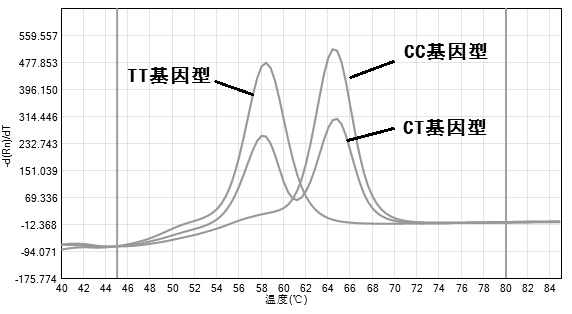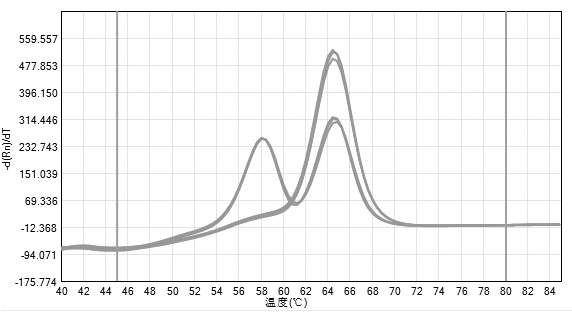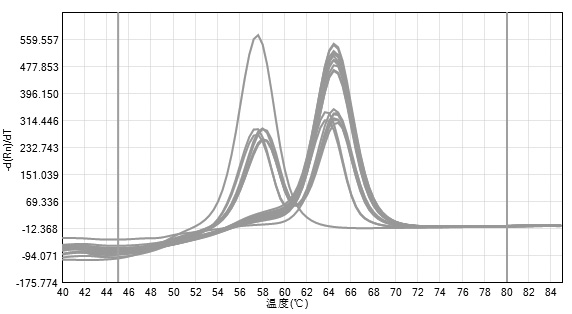Probe, primer and kit for detecting interleukin-3 gene polymorphism
A gene polymorphism and interleukin technology, applied in the field of molecular biology, can solve the problems of high cost, time-consuming and laborious, unsuitable detection, etc., and achieve the effect of simple operation, high sensitivity, and clear genotyping
- Summary
- Abstract
- Description
- Claims
- Application Information
AI Technical Summary
Problems solved by technology
Method used
Image
Examples
Embodiment 1
[0025] Example 1 Design of probes and primers
[0026] The present invention designs probe and primer sequences aiming at IL3 C>T SNP site. The specific principle is to use the conformational change of the fluorescent probe and the target sequence after hybridization to release the fluorescent dye, and judge the genotyping results according to the peak diagrams and Tm values at different temperatures after hybridization. In the absence of target DNA, the fluorophore and quencher can be stably combined together, and no fluorescent signal can be detected; when there is target DNA, the structure of the fluorescently labeled probe is destroyed, and the fluorophore and quencher The extinguishing groups are separated from each other, and the fluorescent signal can be detected.
[0027] Design probes and primers so that when the template does not exist at the annealing temperature, the probe is in a stem-loop state, including the loop sequence and the reverse-complementary stem se...
Embodiment 2
[0034] Example 2 Detection of different genotype standard products
[0035] 1. Use the plasmid IL3 C>T to construct and prepare wild-type standard plasmids and mutant standard plasmids containing the rs31480 site of the target gene (the source of the plasmid and the synthesis of the plasmid containing the target gene are provided by Sangon Bioengineering (Shanghai) Co., Ltd. Synthesized by the company. The accuracy of the sequence was determined by sanger sequencing. The genotype of the wild-type standard plasmid rs31480 is CC;
[0036] 2. Using the probes and primers in Example 1.
[0037] 3. PCR reaction system:
[0038] 1) Add 7.5ul of PCR Mix, 0.5uM of primer 1 solution and 0.5uM of primer 2 solution, and 0.1uM of probe into each PCR reaction well, and then add wild-type standard plasmids into 3 different PCR reaction wells respectively 2ul each of DNA, mutant standard plasmid DNA, and mixed DNA (the wild-type standard plasmid and mutant standard plasmid are mixed at a r...
Embodiment 3
[0041] Embodiment 3: detection method performance analysis experiment
[0042] 1. Precision experiment
[0043] Take one copy of wild-type standard plasmid DNA and one mixed-type DNA (the wild-type standard plasmid and the mutant standard plasmid are mixed at a ratio of 1:1), and test 3 times a day for 5 consecutive days. The method in example 2, see the result figure 2 . It shows that the fluorescent PCR amplification reaction of the present invention has good repeatability (the coincidence rate is greater than 95%, and the coefficient of variation CV of the Ct value of the test result is less than 5%).
[0044] 2. Conformity rate experiment
[0045] Select 20 cases of DNA samples from healthy volunteers in Shanghai, apply the method of Example 2 to detect the rs31480 locus, and apply the Sanger sequencing method to verify at the same time, compare the consistency of the detection results of the two methods, the results show that the method of Example 2 can be classified T...
PUM
 Login to View More
Login to View More Abstract
Description
Claims
Application Information
 Login to View More
Login to View More - R&D
- Intellectual Property
- Life Sciences
- Materials
- Tech Scout
- Unparalleled Data Quality
- Higher Quality Content
- 60% Fewer Hallucinations
Browse by: Latest US Patents, China's latest patents, Technical Efficacy Thesaurus, Application Domain, Technology Topic, Popular Technical Reports.
© 2025 PatSnap. All rights reserved.Legal|Privacy policy|Modern Slavery Act Transparency Statement|Sitemap|About US| Contact US: help@patsnap.com



